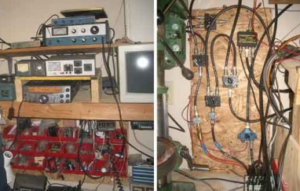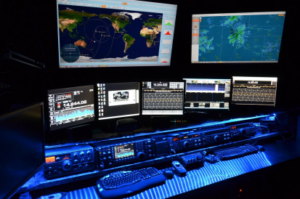Ham Radio Shack – what’s inside?
 When someone hears the words “ham radio shack” he imagines the small windowless room in the attic filled with all kinds of radio boxes and hundreds of meters of coax and electric wires, stretched along the walls and lying randomly on the floor.
When someone hears the words “ham radio shack” he imagines the small windowless room in the attic filled with all kinds of radio boxes and hundreds of meters of coax and electric wires, stretched along the walls and lying randomly on the floor.
This image has been ingrained in the minds of ordinary people since hams were building their rigs, antennas, and even Z80 computers themselves.
The time has changed and nowadays the overwhelming majority of hams are not building their station’s items themselves but just buying them. As a result, the view of ham radio shacks is becoming completely different. They don’t look like workbenches anymore but rather like airliner cabins.

Paradoxically, despite of the different and updated shack’s view, their main ingredients remain the same for decades.
Let’s take a closer look at this phenomenon and list the necessary items for a successful and efficient ham radio station.
Item 1. Receiving and transmitting equipment.
Many years ago hams used separate receivers and transmitters, and then the first analog transceivers with additional second VFO were built. Synthesized transceivers were the next step and the separate second VFO wasn’t needed anymore. These are widely used and still the most popular transceivers among hams. Recently, so-called, “direct sampling” SDR transceivers have appeared on the market. The popularity of ICOM IC7300 shows the big potential for this technology.
Anyway, one can work with Bouvet I. DXPedition by using the ancient tube-type transceiver or a $10k state-of-art 200-watt rig. What’s really important is that there has to be a transceiver in the shack!
Item 2. Power Amplifier.
For successful DXing and contesting the legal power linear amplifier is a must.
Gerry King VE3GK in his book “The Gain Game” has clearly shown that any mainstream DXer can easily add 10 dB to the reference 100 watt into a dipole signal by using the power amplifier. Another 7 dB will be added by using the 3-element monoband antenna.

The amplifier can be either tube or transistor type.

Recently the auto-tune option was added to the high-power tube amplifiers. This is helpful when the ham station is operated remotely including the band and mode switching, rotating the antenna, and keying the radio. Transistor power amplifiers are broadband by nature.
Item 3. Computer.
Adding the computer to the ham radio shack gives the operator a lot of different useful options:
- digital modes of operation (including FT4/8)
- full control of transceivers and linear amplifiers
- rotating the antenna by special software like PSTRotator, etc
- using general and contest loggers
- using the LoTW and eQSL databases for award hunting
- using DXCluster, hamspots.net, PSKreporter and other information networks for the realtime DX-ing
- remote operation capabilities.
The modern desktop computer with a video card that supports at least 2 monitors and a motherboard with PCI and PCIe slots for adding additional sound, I/O, etc cards are preferred.
Item 4. Station Accessories.
- Interface devices to key and PTT the radio. These can be home or commercially made. RigExpert TI-3000 and TI-5000 are powerful USB transceiver interfaces based on high-quality stereo codec IC, for operating phone, CW, and digital modes
- Rotator controllers to rotate the antenna and control the azimuth and elevation direction angle like https://ea4tx.com/en/tienda/antenna-rotator-system/ars/ or homemade Arduino https://github.com/k3ng/k3ng_rotator_controller
- Power supplies. 13.8V is needed for transceivers and other equipment with no internal power supplies. RigExpert Shackmaster™ Power 500 DC power supply can be an ideal solution for this purpose
- Relay switching boxes to switch antennas
- Band filters for multi-contest stations
- Ethernet relay units to remotely switch the equipment in the shack
- High-speed Ethernet router for Internet connection and internal station’s LAN Item 5. RF Measuring Equipment and accessories.
- High Power 3 kW SWR meter
- 3 kW dummy load
- Antenna analyzer. This instrument is absolutely necessary for antenna and coax measurements. Depending on the bands of interest one can choose the needed RigExpert AA or Stick model. Their advantages over other manufacturer’s units are:
- compact size and small weight compared to competitors
- low 5V voltage instead of 14V used by MFJ that uses 10 AAor Ni-MH batteries (not included)
- large LCD screen with ZOOM option
- memory slots to save measurement results
- immunity to high RF fields
- ability to work with RigExpert© AntScope2 software to show measurement results on the “big screen”

